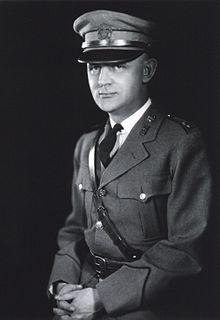John F. Mahoney
John Friend Mahoney (born August 1, 1889 in Fond du Lac , Wisconsin , † 1957 ) was an American doctor , known as the pioneer of the treatment of syphilis with penicillin .
life and work
Mahoney graduated from Marquette Medical College in Milwaukee in 1914 with clinical training (internship) at Milwaukee County Hospital and Chicago Lying-in Hospital (maternity hospital ). From 1917 he was first employed as an assistant surgeon in the US troops in Europe during World War I. After returning in 1919, he served in the Public Health Service (PHS) at various quarantine stations and marine hospitals, including the Ellis Island immigration station in New York City . In this context he was sent to Europe (England, Ireland, Germany) for study purposes from 1925 to 1929, where he also studied syphilis treatment.
Mahoney was director of the United States Public Health Service's Veneral Disease Research Laboratory , attached to the Staten Island Marine Hospital , since 1929 . Among other things, the laboratory improved serological tests for syphilis and demonstrated its effectiveness in gonorrhea with the advent of sulfonamide treatment in the United States in the 1930s . During World War II he was also Medical Director of the Marine Hospital in Staten Island.
Mahoney became aware of penicillin treatment options through a paper by Wallace Herrell and colleagues at the Mayo Clinic on the treatment of gonorrhea patients in whom the pathogen was resistant to sulfonamides. Mahoney was able to confirm this and also began testing penicillin for syphilis, first in vitro (unsuccessfully), then in rabbits and, when this was successful, in clinical tests. He presented the first results (on four patients at an early stage of the disease) at a meeting of the American Public Health Association in New York in October 1943, which immediately met with a great response. Among other things, it was reported in Time Magazine and the Committee on Medical Research began a larger clinical study (with over 1,400 patients in various hospitals), in which Mahoney was also involved. He led the investigation into the study at the Staten Island Marine Hospital . In June 1944, penicillin was introduced as the standard treatment for syphilis in the US Army, followed by the British. This also led to conflicts about the use against sexually transmitted diseases (which was initially preferred in North Africa, for example, since the soldiers could be made ready to fight again immediately) or wound infections.
In 1946 Mahoney was one of the first to receive the Albert Lasker Award for Basic Medical Research . In 1948 he became chairman of the WHO Expert Committee on STDs at its first meeting in Geneva. December 1949 he retired from the PHS, but continued his career as Health Commissioner for the City of New York City (1950 to 1953) and thereafter until his death as director of the laboratories of the New York City Health Department.
He was married and had two sons.
literature
- John F. Mahoney: Some of the Early Phases of Penicillin Therapy Against Syphilis. In: American Medical Association: Archives of Dermatology Vol. 73, Vol. 5, 1956, pp. 485-488.
Web links
- John Parascandola: John Mahoney and the introduction of penicillin to treat syphilis (PDF; 87 kB)
- Obituary in the British Journal of Veneral Diseases, Volume 33, 1957, p. 127. PMC 1047143 (free full text)
Individual evidence
- ^ Wallace Herrel, Edward Cook, Luther Thompson: Use of Penicillin in Sulfonamide Resistant Gonorrheal Infections. In: Journal of the American Medical Association, Vol. 122, May 1943, pp. 289-292.
- ^ JF Mahoney, RC Arnold, A. Harris: Penicillin Treatment in Early Syphilis. In: American Journal of Public Health , Volume 43, 1943, pp. 1387-1391.
- ^ New Magic Bullett, Time Magazine, October 25, 1943.
- ↑ First results were published by Mahoney and colleagues in 1944. Joseph Earle Moore, Mahoney, Walter Schwartz, Thomas Sternberg, W. Barry Wood: The Treatment of Early Syphilis with Penicillin. A preliminary report with 1418 cases. In: Journal of the American Medical Association, Volume 126, 1944, pp. 67-72. Mahoney, RC Arnold, Burton Sterner, Ad Harris, MR Zwally: Penicillin Treatment of Early Syphilis II. In: Journal of the American Medical Association, Volume 126, 1944, pp. 63-67.
| personal data | |
|---|---|
| SURNAME | Mahoney, John F. |
| ALTERNATIVE NAMES | Mahoney, John Friend (full name) |
| BRIEF DESCRIPTION | American medic |
| DATE OF BIRTH | August 1, 1889 |
| PLACE OF BIRTH | Fond du Lac |
| DATE OF DEATH | 1957 |
